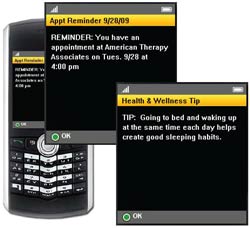Army employs text messages to help treat wounded soldiers
November - December, 2009 | Volume 8, Issue 6
One application of mobile communication devices that is less well known is their use in the treatment of U.S. soldiers wounded in combat. Caring for soldiers' injuries while evaluating whether the patient should stay on active duty or retire can be a lengthy and tumultuous process. In many cases, the returning service members live great distances from major military medical facilities and from their case managers.
A new army program using secure text messaging to communicate regularly with soldiers wounded in combat is helping to make this transition an easier process. Called mCare, the outreach effort works with the service member's personal cell phone, and strives to create continuous connectivity between the patient, their platoon sergeants and case workers, and informal caregivers such as family members and spouses.
In its first phase, the program is being used at five facilities across the U.S, helping between 70-100 wounded soldiers. Teams overseeing the treatment of the soldiers create personalized messages on a Web site. The messages are sent to a soldier's cell phone, he or she responds to the messages, and the care team views the responses and creates online reports based on them.

Photo courtesy of U.S. Army
Frequent contact with the patients is crucial, as wounded soldiers can become isolated or forgetful of routines. "A lot of these of these soldiers may be suffering from traumatic brain injury or post-traumatic stress disorder," according to Col. Poropatich, M.D., from the Army's Telemedicine and Advanced Technology Research Center at Fort Detrick, Md.
A color coding system is used for the responses, with green signifying the soldier is doing well, red indicating he or she is not doing well and black meaning there was no reply. "If it's black or red, we're worried," he said.
Sometimes the texts are helpful tips, reminders of appointments or even news items or jokes, but Poropatich says they all play an important role in the soldiers' treatment.
To view Adobe PDF files,
download current, free accessible plug-ins from Adobe's website.